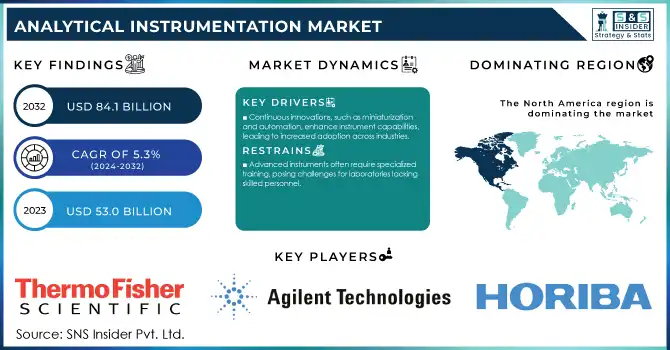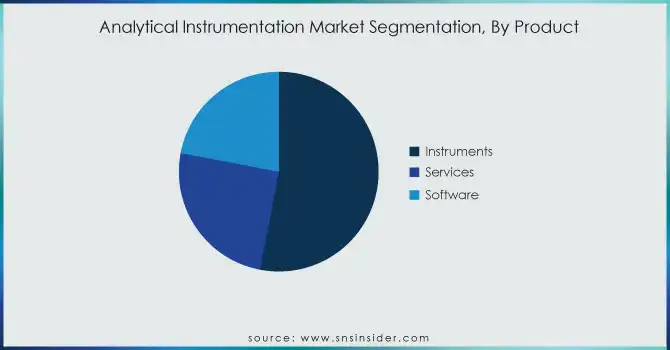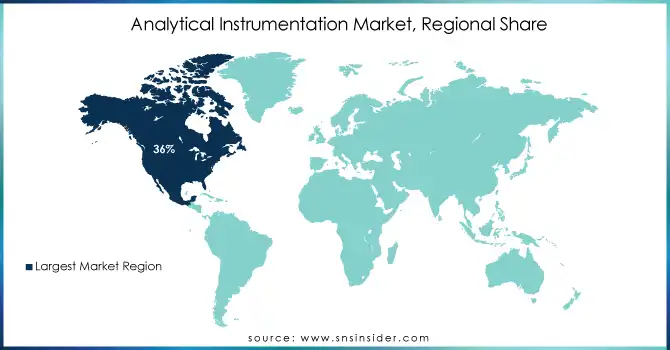Analytical Instrumentation Market Size Analysis:

Get more information on Analytical Instrumentation Market - Request Sample Report
The Analytical Instrumentation Market Size was valued at USD 53 Billion in 2023 and is expected to reach USD 84.1 billion by 2032, growing at a CAGR of 5.3% over the forecast period 2024-2032.
The analytical instrumentation market is expected to grow exponentially, due to rising focus on product quality along with stringent regulatory frameworks and proliferating technology across several sectors. Governments around the globe are the most important driving force of this growth by massively investing in research and development (R&D) and infrastructure improvement. In India, the Department of Science and Technology (DST) allocated ₹16,628 crore for the Ministry of Science and Technology in the fiscal year 2024-25, marking a 31% increase from the previous year. Full funding to underpin initiatives such as the SUPREME program, which helps fund upgrades and maintenance of analytical instrumentation facilities (AIFs). They are national programs designed to improve research capacity and aid local compliance with international standards, which ultimately leads to innovation and improved product quality. Government agencies including the National Institutes of Health (NIH) have also played an active role in providing funding for biomedical research and thereby boosting the growth of the market in North America. The NIH devoted an estimated $51 billion to healthcare R&D in 2023, which includes funding for analytical tools important to drug development and diagnostics over $177 million to researchers to integrate predictive computing into drug development, and used the remainder of the budget to improve point-of-care information systems.
Additionally, the U.S. Environmental Protection Agency (EPA) emphasizes the necessity of precise measurement technologies for monitoring pollutants like PFAS (per- and poly-fluoroalkyl substances). This has fueled the need for high-end analytical equipment in environmental applications. In addition, analytical tools like critical dimension small-angle X-ray scattering (CD-SAXS) that have been developed by the National Institute of Standards and Technology (NIST) are also revealing trends in semiconductor fabrication. The market is being governed by trends such as the miniaturization of instruments, the incorporation of artificial intelligence (AI) and machine learning (ML), and advances in spectroscopy across the globe. Emerging technologies such as surface-enhanced Raman spectroscopy (SERS) and nuclear magnetic resonance (NMR) are now capable of in-depth molecular analyses for pharmaceutical, forensic, and environmental applications. The innovations come at a time of increasing worldwide worries about food safety, drug performance, and ecological sustainability.
Analytical Instrumentation Market Dynamics
Drivers
-
Continuous innovations, such as miniaturization and automation, enhance instrument capabilities, leading to increased adoption across industries.
-
Stringent regulations in sectors like pharmaceuticals and food safety necessitate precise analytical instruments to ensure product quality and safety.
-
The growing emphasis on personalized medicine and diagnostics drives the need for advanced analytical tools in research and clinical settings.
The development of advanced technology is one of the major factors driving the growth of the analytical instrumentation market as these instruments become more accurate, efficient, and versatile. The capabilities of analytical instruments have been widened with continuous innovations in automation, miniaturization, and artificial intelligence (AI) integration, which have made the analytical instruments easier to use and attractive to a wide range of industries, including healthcare and environmental monitoring. For example, advancements in chromatography instruments, such as high-performance liquid chromatography (HPLC), have allowed for faster, more precise analyses of complex chemical samples. Furthermore, AI in spectroscopy allows for instant data processing and analysis directly in the spectroscopy devices, which eliminates human error and subsequently boosts throughput. Moreover, due to the reduced size of the instruments, small and portable devices can be developed that would enable on-site and field testing, particularly for environmental and clinical applications.
The emergence of electronics, machinery, and new technological techniques that are also AI-based analytic tools will enhance laboratory protocols and work, thus allowing labs to process more samples with higher precision. In addition, time and costs are also predicted to be saved by AI in diagnostics, as machine learning algorithms are increasingly integrated into diagnostic devices that analyze imaging data or molecular samples of patients to identify a disease. Such technological advancements enhance efficiency, create new applications, and contribute to the reliability of analytical instruments, thereby driving demand in various industries.
Restraints:
-
The substantial investment required for advanced analytical instruments can deter adoption, especially among small and medium-sized enterprises.
-
Advanced instruments often require specialized training, posing challenges for laboratories lacking skilled personnel.
-
Ongoing maintenance and calibration needs add to the total cost of ownership, potentially limiting market growth.
One key factor restraining the growth of the global analytical instrumentation market is the high cost of the instruments. While these advanced analytical instruments are necessary for accurate measurements and even complex analyses, they often cost a pretty penny. The costs associated with the larger array of instruments are often high, which can be a significant barrier to entry for smaller laboratories, research institutions, and businesses in developing regions with tighter budgets. The immediate cost of purchasing was only one part of its contribution to the financial burden, as well as the regular maintenance and repairs and the large number of upgrades in very little time. Hence, the costs of specialized training that feeds these instruments into the hands of Operators also add to the monetary implication of such testing. This amount of money is hard to justify for smaller companies or organizations, potentially compromising their ability to adopt the latest technologies. In some industries, particularly those that are sensitive to price, this can restrict innovation and limit market growth.
Analytical Instrumentation Market Segmentation analysis
By Products
The analytical instrumentation market was dominated by the instruments segment and accounted for more than 53% share in 2023. The reason behind the dominance of regulatory compliance instruments is their important role in regulatory compliance within companies in the pharmaceutical and biopharmaceutical sectors. The government is investing in Sophisticated Analytical Instrument Facilities (SAIF) which provide important analytical equipment for research institutions where such tools are unavailable to further improve R&D infrastructure. There are presently 15 scientific services using such high-end instruments including mass spectrometers & chromatographs SAIF centers spread across India. This is part of the DST initiative to update the latest technology at these facilities to enable them to carry out their functions more efficiently. Government funding has also been channeled into advanced instrument development to international standards, which is vital for industries under increasing pressure to demonstrate product safety and efficacy. This drive to improve analytical instruments is in accordance with the global trend of experiencing the need for precision and reliability in every product testing and quality assurance.

By Technology
The polymerase chain reaction (PCR) segment held a significant 23% of the market share in 2023 due to its critical role in diagnostics and life sciences research. Over just a few decades PCR technology development received significant funding from the U.S. National Institutes of Health (NIH). As disease outbreaks, such as the COVID-19 pandemic demonstrated, are key for public health, the need for rapid testing has been essential. NIH spent about $1 billion to improve diagnostic capacity using more sophisticated tests such as PCR. In addition, the European Medicines Agency (EMA) has also expedited the approval procedure of the PCR testing devices, thus facilitating laboratory use. National policies promoting research on next-generation PCR technologies have also contributed to a rise in sensitivity and specificity in genetic diagnostics. Consequently, PCR evolved into an integral technology, required not only for the detection and diagnosis of infectious diseases but also for personal information applications providing genetically based sample typing. This increasing dependence on PCR technology highlights its role in addressing the demands of public health and in facilitating scientific advancement.
By Application
The life sciences R&D segment held an impressive 45% share in 2023 of the analytical instrumentation market due to its critical role in the development of imperative healthcare solutions through research and innovation. This sector relies heavily on government funding in FY 2023, the NIH allocated around $51 billion towards its budget for biomedical research which reflects the well-established priority given to life sciences research. Over the last few decades, the government has taken a larger role in improving the healthcare infrastructure by investing heavily in R&D, as indicated by a recent report placing the contribution of biotechnology research by the Department of Biotechnology (DBT) at about ₹969 crore, biotechnology as part of national health strategies has grown over time in India. Also, programs such as the SATHI program are focused on the creation of centers for collaboration between academia and industry, with state-of-the-art analytical instruments made available for use by industries. Such efforts are aimed at fostering a culture of innovation underpinning life sciences research as well as enabling researchers to access the advanced tools that will facilitate these discoveries.
Regional Insights
North America has led the analytical instrumentation market with the 36% market share in 2023. Numerous R&D activities requiring advanced analytical tools and the well-established healthcare and pharmaceutical sectors of the region drive growth. Specifically, the United States is still one of the major contributors with a high investment in technological advancements backed up with the presence of significant players like Thermo Fisher Scientific, Agilent Technologies, and PerkinElmer. Analytical instrumentation in North America has been driven by the increasing quality control and regulatory compliance, and the growth in various research areas, particularly the life sciences, environmental monitoring, and chemical analysis. It has a robust innovation ecosystem, with universities, government agencies, and private industry working together to break new ground in science and technology.
In contrast, Asia-Pacific is expected to register the highest growth through the forecast period with a considerable CAGR. Driving this growth is the fast pace of industrialization and urbanization in nations like China, India, Japan, and South Korea. These countries are pouring investment into health care, pharmaceuticals, environment monitoring, and manufacturing which require accurate and efficient analytical instruments. Consumer demand for high-quality products, and an increase in research and development, are also aiding in the adoption of analytical instruments in the region. Additionally, it has a growing and potential-rich consumer market with increasing demand for industrial automation and advanced quality control procedures in the region. This increase in market growth is bolstered by the government's efforts and the subsequent emergence of local manufacturers. As a result, Asia-Pacific is poised to become a major player in the global analytical instrumentation market, with rapid technological advancements and a broadening user base.

Do You Need any Customization Research on Analytical Instrumentation Market - Enquire Now
Key Players
Key Service Providers/Manufacturers
-
Thermo Fisher Scientific (Nicolet iS50 FTIR Spectrometer, Dionex ICS-6000 Ion Chromatography System)
-
Agilent Technologies (7890B Gas Chromatograph, 5100 ICP-OES)
-
Horiba Ltd. (LA-950V2 Laser Diffraction Particle Size Analyzer, U-5100 Spectrophotometer)
-
ABB Ltd. (PIR700i Process Infrared Analyzer, 800XA Process Automation)
-
PerkinElmer (Flexar FX-15 HPLC, AxION 2 TOF Mass Spectrometer)
-
JASCO Corporation (V-650 UV-Vis Spectrophotometer, FT/IR-4700)
-
Schimadzu Corporation (Nexera UHPLC System, LCMS-8060 Triple Quadrupole Mass Spectrometer)
-
Sartorius AG (Entris II Laboratory Balances, Cubis II Lab Balances)
-
Mettler Toledo (SevenExcellence pH Meter, TGA/DSC Thermogravimetric Analyzer)
-
Bruker Corporation (UltraFlex III MALDI-TOF Mass Spectrometer, MATRIX-F FT-IR Spectrometer)
Users of Analytical Instrumentation Products
-
University of California, Berkeley
-
National Institutes of Health (NIH)
-
Pfizer Inc.
-
Roche Diagnostics
-
Merck & Co.
-
BASF SE
-
ExxonMobil
-
Chevron Corporation
-
Dow Chemical Company
-
Shell Global Solutions
Recent Developments
-
In June 2023, Thermo Fisher Scientific announced the launch of a new mass spectrometer Orbitrap Astral for proteomics & precision medicine . Based on the company's Orbitrap platform, the new system provides up to 2X proteome coverage and 4X throughput over existing mass spectrometers to enable quicker throughput of larger cohorts.
-
In June 2023, Agilent Technologies released two mass spectrometry systems for advanced liquid chromatography-mass spectrometry, Agilent 6495D LC/TQ and Agilent Revident LC/Q-TOF systems Designed for high-sensitivity, difficult targeted analysis, these systems enhance Agilent's portfolio of leading analytical instruments worldwide.
| Report Attributes | Details |
|---|---|
| Market Size in 2023 | USD 53 Billion |
| Market Size by 2032 | USD 84.1 Billion |
| CAGR | CAGR of 5.3% From 2024 to 2032 |
| Base Year | 2023 |
| Forecast Period | 2024-2032 |
| Historical Data | 2020-2022 |
| Report Scope & Coverage | Market Size, Segments Analysis, Competitive Landscape, Regional Analysis, DROC & SWOT Analysis, Forecast Outlook |
| Key Segments | • By Technology (Polymerase Chain Reaction, Spectroscopy, Microscopy, Chromatography, Flow Cytometry, Sequencing, Microarray, Others) • By Product (Instruments, Services, Software) • By Application (Life Sciences Research & Development, Clinical & Diagnostic Analysis, Food & Beverage Analysis, Forensic Analysis, Environmental Testing, Others) |
| Regional Analysis/Coverage | North America (US, Canada, Mexico), Europe (Eastern Europe [Poland, Romania, Hungary, Turkey, Rest of Eastern Europe] Western Europe] Germany, France, UK, Italy, Spain, Netherlands, Switzerland, Austria, Rest of Western Europe]), Asia Pacific (China, India, Japan, South Korea, Vietnam, Singapore, Australia, Rest of Asia Pacific), Middle East & Africa (Middle East [UAE, Egypt, Saudi Arabia, Qatar, Rest of Middle East], Africa [Nigeria, South Africa, Rest of Africa], Latin America (Brazil, Argentina, Colombia, Rest of Latin America) |
| Company Profiles | Thermo Fisher Scientific, Agilent Technologies, Horiba Ltd., ABB Ltd., PerkinElmer, JASCO Corporation, Schimadzu Corporation, Sartorius AG, Mettler Toledo, Bruker Corporation |
| Key Drivers | • Continuous innovations, such as miniaturization and automation, enhance instrument capabilities, leading to increased adoption across industries. • Stringent regulations in sectors like pharmaceuticals and food safety necessitate precise analytical instruments to ensure product quality and safety. |
| Restraints | • The substantial investment required for advanced analytical instruments can deter adoption, especially among small and medium-sized enterprises. • Advanced instruments often require specialized training, posing challenges for laboratories lacking skilled personnel. |

